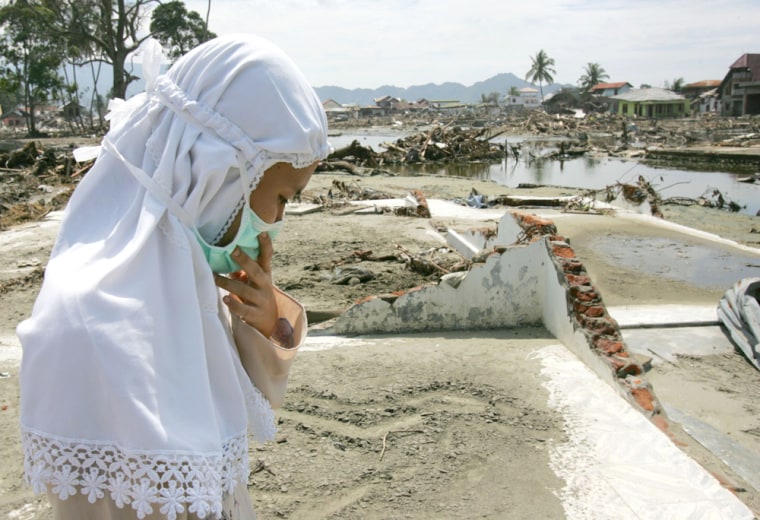Indonesia's Health Ministry raised the country's death toll from the Dec. 26 tsunami to 166,320 on Wednesday, pushing the total number of people killed in the disaster above 225,000.
A Health Ministry statement said the new figure was based on latest reports from the provinces of Aceh and North Sumatra, which were directly in the path of the killer tsunami spawned by a magnitude-9 earthquake the day after Christmas.
The new death toll — a jump of more than 50,000 on the ministry's last figure — includes many people who were previously listed as missing, a senior ministry official told Reuters.
Meanwhile, a U.N. official said emergency aid deliveries to remote areas of Aceh province will have to increase sharply to avoid serious hunger and other problems. Daniel Augstburger, head of the United Nations Office for the Coordination of Humanitarian Affairs (OCHA) in the coastal city of Meulaboh, said not enough help was reaching people outside of major urban areas.
“The French are starting to move food, of course the Americans... are moving food out, but this has to increase ten-fold, I would say,” Augstburger told Reuters, adding that tsunami victims also needed items such as clothes and cooking utensils.
Meulaboh, about 150 miles south of the provincial capital of Banda Aceh, was cut off for several days following the Dec. 26 tsunami, which killed some 115,000 in the province and demolished large areas of coastline.
Not enough transportation
Augstburger said that despite a huge international relief operation involving military forces from a number of countries, there were still not enough helicopters and boats available to deliver the needed aid.
He said if that didn’t happen, things could become “very serious” in outlying areas.
“The food is here. We have to deliver the food. Stocks are being piled here (in Meulaboh),” he said.
Officials say one problem is the need for repeated air drops in the same area. With many villages completely wiped out, and others coping with an influx of refugees, a constant schedule of aid deliveries needs to be established to keep people supplied.
“The magnitude of the needs are such that we might be here for a pretty long time,” Augstburger said.
Aid deliveries in much of coastal Aceh are hampered by the lack of roads, many of which were destroyed by the tsunami. The coast is also virtually without working harbors or ports, making sea deliveries difficult.
Also, officials remain concerned about security in Aceh. U.N. officials on Tuesday lifted a travel ban they had imposed earlier in parts of the region because of fears of possible attacks on aid convoys, but they also urged continued vigilance.
Augstburger said despite the challenges, some aspects of life were returning to normal in and around Meulaboh, where hospitals are now functioning and school is due to reopen on Monday.
“What is striking is that there are smiles here...I’m 20 years in this business and what I see is a very positive reaction,” he said.
Annan urges disaster prevention
On Tuesday, U.N. Secretary General Kofi Annan urged rich nations to spend more on preventing natural disasters before the next one hits.
Annan, in a video address to an international conference in the Japanese city of Kobe, where a killer earthquake struck 10 years ago, said the world should prepare now for future catastrophes.
“It’s not enough to pick up the pieces,” Annan said after a minute of silence for the tsunami’s victims. “We must draw on every lesson we can to avoid such catastrophes in the future.”
At at the conference, multiple nations are putting forward projects for a tsunami-warning system, but there was disagreement about how to make it work.
Amid a large number of overlapping proposals, U.N. officials called Wednesday for coordination of efforts — and insisted on their own central role in marshaling the expertise and setting up the system.
“The event was of such magnitude that we have seen forthcoming some very interesting and very complete proposals,” said Patricio Bernal, executive secretary of the U.N.’s Intergovernmental Oceanographic Commission, which coordinates a warning system in the Pacific.
But, he said, “we feel we need to provide the common platform.”
American officials, however, question the ability of the United Nations to coordinate the program.
The United Nations “has to prove it has the capacity to do so,” said Mark Lagon, U.S. deputy assistant secretary of state. “There’s no substitute for the will of the nations with the resources and the technology.”
The United States has announced a massive plan to bolster its own defenses against tsunami and wants to take a leading role in the international effort.
The agenda for the first day of the five-day meeting focused on routes to resilience: by protecting such critical facilities as hospitals and power plants against damage, building earthquake-safe structures and bolstering communications systems, among others.
U.N. officials suggested that rich nations spend 10 percent of their emergency aid budget on cutting disaster risk through measures such as tsunami early warning systems, which experts say might have saved some of the more than 175,000 lives taken by last month’s giant waves.
“Rarely has a tragedy made a conference so topical and timely as this one,” Annan said.
International pledges of emergency relief for tsunami victims now stand at more than $7 billion.
